How to Design Food Packaging
By: phase1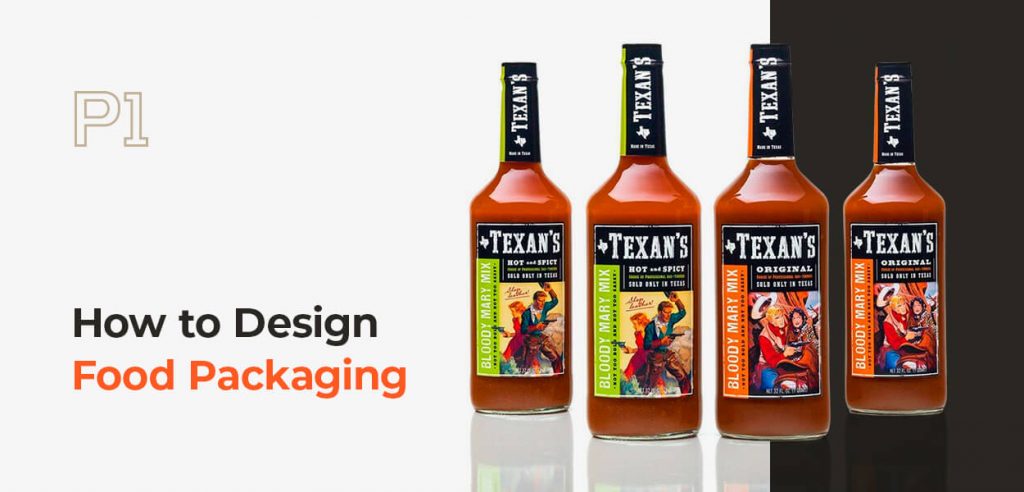
The food industry continues to grow as companies expand their ventures into new territories that tantalize their customers’ taste buds. Consumers have their favorite foods, but many are on a mission to find their next favorite thing. The high competition within the food industry reveals the primary function of food packaging, which is to set your brand apart from the crowd.
With creative, unique food packaging, you can pique the interest of your buyers to make a sale. The process of making great packaging includes various factors like colors, fonts, texture and so much more. You must learn how to design food packaging to ensure success for your food business and establish your brand identity.
Read on for the food packaging design tips you need to get started.
1. Conduct Market Research
When you create food packaging, you must take several elements into consideration. For your initial food packaging design inspiration, research your market to gain essential insight into the direction you should go. That way, you start the whole process with usable data to make more informed, confident food packaging design decisions.
Start the market research phase by taking a deeper look into your industry. Ask yourself some questions like these:
Who Is My Competition and How Are They Designing Their Packaging?
Identify your competition within your specific market to determine who you’re competing with and how they sell their products. You can learn a lot about packaging design from your competition, including practices to emulate and avoid. Look for factors like package size, text font and colors. See what’s trending and what’s performing poorly. Study how customers react to your competition’s design decisions, especially when your competition changes designs or undergoes a rebrand.
Are There Any Regulations Regarding Packaging That I Need to Follow?
One of the most essential packaging design tips you can follow is abiding by all necessary regulations regarding your product packaging. The last thing you want is a fine or needing to recall your products because of package design discrepancies. You’ll want to pay special attention to the rules set by the Federal Drug Administration (FDA) and the United States Department of Agriculture (USDA).
Who Are My Customers?
Poor packaging design decisions forget to take your customers into consideration. Think of who your customers are and what they want from you as a company. Whether your customers are looking for specific information on the packaging or a certain material, you want to make sure you’re doing something that will earn their business. Continue to the next section for more information on the importance of knowing your customers when creating your food packaging design.
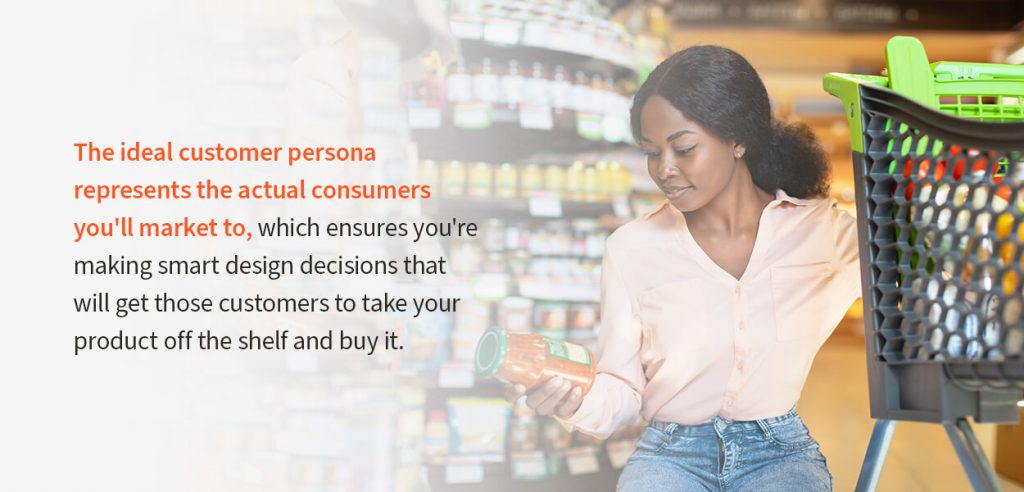
2. Imagine Your Ideal Customer
When you market your food products, you must market to a specific type of customer. More specifically, you want to market to your ideal customer — the customer who stands to provide the highest value to your business. If you design your packaging to appeal to a broad audience or no particular group, then you might miss out on reaching consumers who would have otherwise bought your product if you had designed your packaging to appeal to them.
Creating an ideal customer persona tells you who you’re marketing to, which will help inform your food package design decisions. An ideal customer persona is a fictitious character with a description so realistic you can confidently market your product toward them. The ideal customer persona represents the actual consumers you’ll market to, which ensures you’re making smart design decisions that will get those customers to take your product off the shelf and buy it.
Here are five steps to help you determine who your customers are so you can create your ideal customer persona:
- Acknowledge the problem your business solves: Does your company provide conveniently packaged lunches for hungry professionals? Do you make a hot sauce that can turn bland food into something exciting? Or maybe you make a crunchy snack food that satisfies your customers’ late-night cravings. Know the problem your customers have and how your product fixes it.
- Research and identify your best customers: If you already have an established business, use your best existing customers as an example of who you should be marketing toward. Use marketing tools like ad engagement and website traffic to analyze the demographics of who is finding and purchasing your products. Finding out relevant customer information will help you fill out some basic characteristics of your ideal customer persona.
- Take positive and negative customer feedback into consideration: To design packaging that works for existing and potential customers, you need to consider all types of feedback, including both positive and negative reviews. There are many ways to discover what your customers are thinking, including phone calls, online surveys and newsletter responses. Through these methods, you can learn more about the problems your customers face and how your packaging design can show them that your product is the answer to their needs.
- Define the most important characteristics of your customers: Once you’ve gained a solid amount of information about your existing customers, it’s time to define the specifics. Try to fill in details like your customers’ age range, geographic location, pain points, goals, family life and budget.
- Create an ideal customer persona to inform your decisions: After you’ve crafted a detailed ideal customer persona, you’re ready to start using it to make more intentional decisions for your branding, labeling, marketing and sales strategies. Rather than wondering what type of label design will impact your customers the right way, use your ideal customer persona to make design choices that resonate with your intended audience.
3. Consider Packaging Materials
Your product’s packaging materials will have a significant impact on its shelf life and durability both on the shelf and in transit. Packaging materials impact product freshness and overall quality, making the type of material you choose an essential part of your quality control strategy. Here are some of the most common types of packaging materials used for food products:
- Glass
- Foils
- Laminates
- Aluminum
- Tinplate
- Tin-free steel
- Paper and paperboards
- Plastics
The FDA regulates product packaging in the United States. Ensure you comply with all FDA regulations as you consider the packaging material you’ll be using for your product. To get your products on store shelves, you’ll need to follow all relevant FDA packaging regulations.
There’s another side to product packaging that you should consider — environmental impact. All product packaging materials impact the environment either positively or negatively. If your company holds environmental sustainability as a pillar of your business model, you should implement sustainable packaging into your design.
Many of your customers will also appreciate your commitment to using sustainable materials. According to a recent study, 57% of consumers are less likely to buy products if they perceive the product packaging to be harmful to the environment. If your business uses environmentally sustainable packaging, let consumers know using your packaging design. Environmentally conscious customers will gravitate toward your products, which could even increase your sales numbers.
Remember, your budget could affect the type of material you use for your packaging. Look at your budget and see how much room you have to experiment. With that, you can test various packaging materials and find what works best for your product’s freshness while appealing to your ideal customer persona.
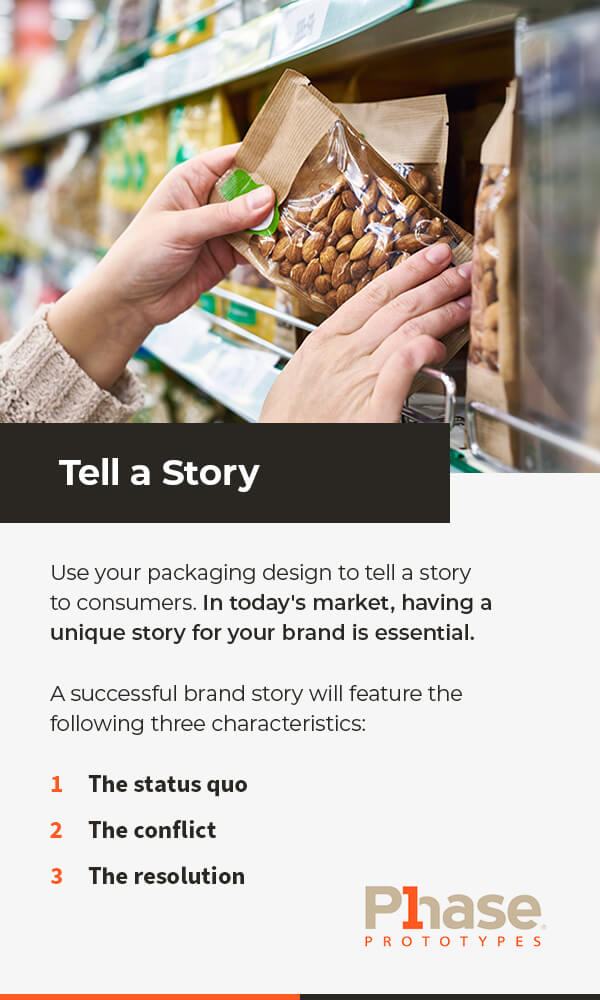
4. Tell a Story
Use your packaging design to tell a story to consumers. In today’s market, having a unique story for your brand is essential. With so many similar products on the market, you need to make your product special by telling your brand’s unique story.
Every company has a brand story. It’s the series of events that led to your brand’s creation and guides your company’s mission in the present. When consumers read your brand story, they have a chance to identify with your company’s passion and empathize with you. Consumers will better remember your brand, and when it comes time to make a purchase, they have a higher chance of choosing your product because they’re emotionally invested in your brand because of the story you told.
A successful brand story will feature the following three characteristics:
- The status quo: The status quo refers to the way things were before you started your business. Life was going on like normal until something happened — the conflict.
- The conflict: The conflict is the event or series of events that disrupted your status quo. The conflict is what forced the protagonist — your business — to step up and find a solution to the problem.
- The resolution: The resolution is how your business solved the problem, which gives audiences an emotional payoff. If they have experienced a similar narrative arc in their own lives, then they will identify with your story and, in turn, your brand. Your product can become the resolution to the conflict that disrupted their status quo.
5. Pick Your Color Scheme Carefully
The color of your food packaging design is vital for tapping into certain consumer emotions. But most of the answers here come down to theory rather than 100% repeatable facts. Color theory is the set of beliefs that ascribe various emotional reactions, associations and connotations to colors. While it can be a tricky science, you should consider how the colors you use affect the perception of your brand.
Partner with a trusted designer for industry insight. You should also note the colors your competition is using, as you may want to follow their lead in some respects or stand apart from them with a completely different color scheme. Your goal should be to match the colors of your design with your brand story for the maximum emotional impact.
One technique to try is to pair your packaging design color with the main ingredient in your product. For instance, a product that uses oranges as the primary ingredient may want to feature the color orange prominently on its label. You can then use other shades of that primary color to make the design a bit more interesting.
If your company sells multiple products, you can set them apart by using different colors on respective packages. You can use the same feel and font on the packages while differentiating your varieties using the power of color.
6. Prep for Feel
After looking at your food product on the shelf, the next way potential customers will interact with it is by touch. Consumers are looking for various tactile sensations like product weight and packaging texture. Your food product packaging design will affect both of these aspects, so you should consider how your packaging’s texture will encourage customers to purchase your product.
Understand how your customers want to interact with your product before buying. For instance, many customers want to lightly squeeze a loaf of bread to determine its freshness. If you package a loaf of bread in an inflexible box, customers may feel confused and like they are unable to trust its freshness.
Instead, you want to promote ownership with your packaging. Give customers control by providing the tactile information they need to make a confident buying decision. Aim for the feel of your packaging to excite consumers into buying your product and experiencing an emotional response that makes them feel good about their purchase.
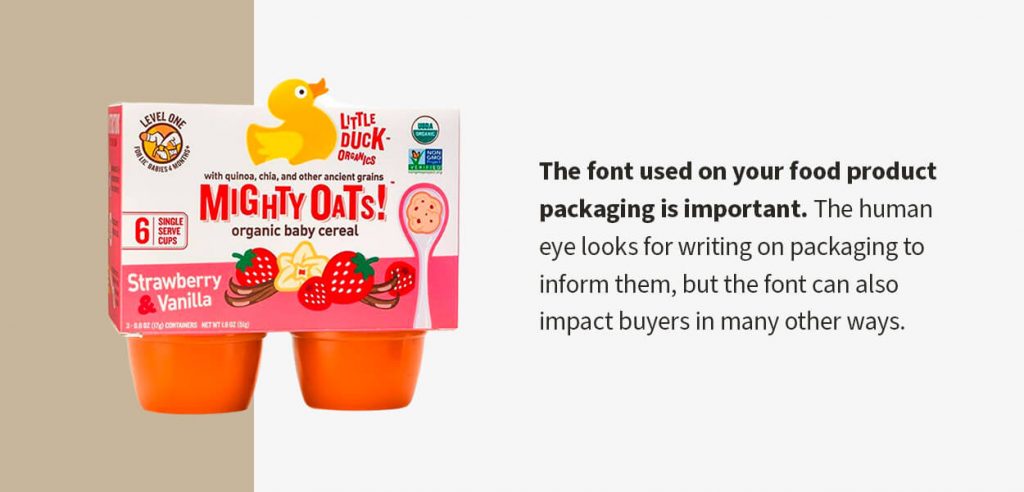
7. Script the Font
The font used on your food product packaging is as important as any of the other points here. The human eye looks for writing on packaging to inform them, but the font can also impact buyers in many other ways.
Ask yourself how your font will make consumers feel. Do you use large, bold and aggressive fonts? Or is your font more flowing and graceful? Now imagine how your font compares to the product you’re trying to sell. Would aggressive lettering make sense on dairy-free milk products? Or would fancy, feathery writing be the best choice for a potato chip brand?
Consider well-known fonts in the food product industry, like Coca-Cola, with its flowing cursive that connotes the image of a smooth flow of Coke from the fountain and a refreshing sip with friends after a long day. Coca-Cola is just one example of the successful use of font in packaging design. Strive for the same level of brand association and positive connotations with the font you use on the packaging of your food product.
8. Keep Location in Mind
Finally, you must consider where you will be selling your product and how the packaging design fits into that. Will your product be on the bottom shelf? If so, you may want to design a custom lid to attract the eyes of consumers. If your product will be at eye level or higher, you must ensure your packaging design will garner attention and stand out from surrounding products.
If you’re selling your product online, will the label be visible in pictures? Will it stand out on sites that sell your product and similar products from other companies? Find answers to these questions to ensure you’re designing packaging that will help your product sell both in-store and online.
Get Packaging That Stands Out With Phase 1 Prototypes
After you’ve created your innovative food packaging design, you’re ready to take the next step toward turning it into a reality. Phase 1 Prototypes can order your designs with fast turnaround times so you can meet your deadlines and make the adjustments you need before getting on the shelves.
Contact us online if you have any questions about our services. If you’re ready to take the next step, then request a quote today!

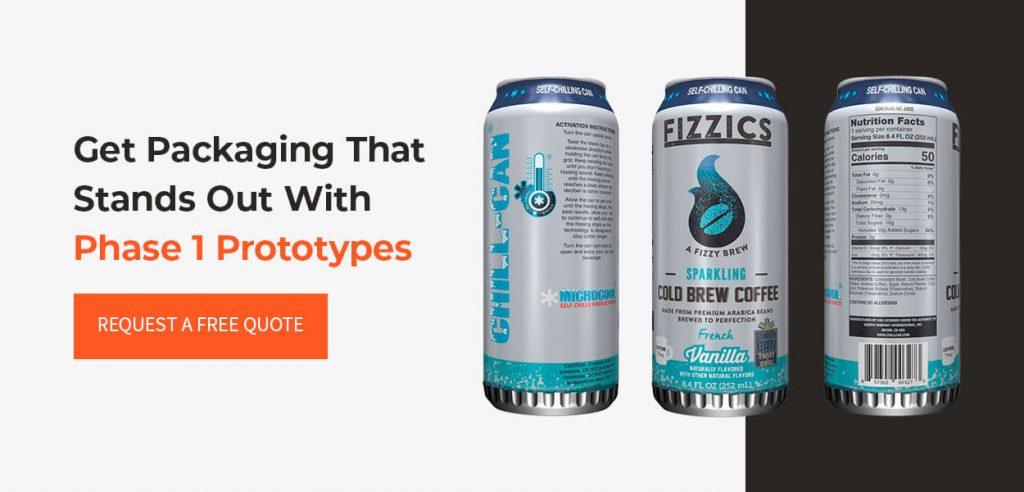
Leave a Reply